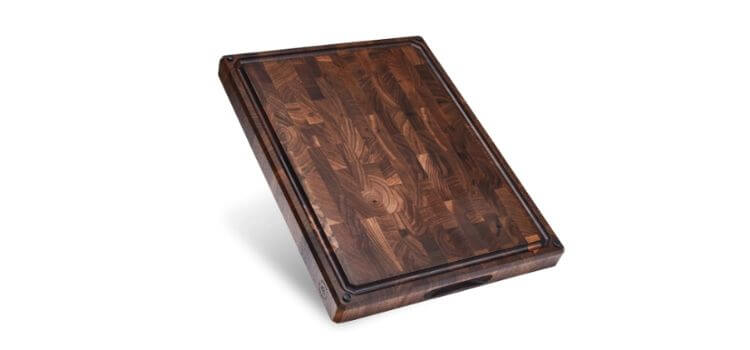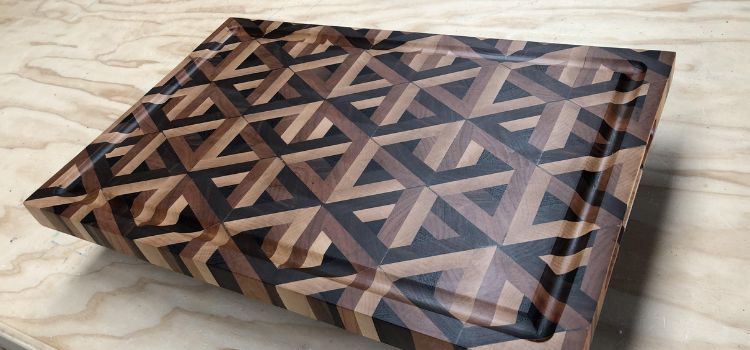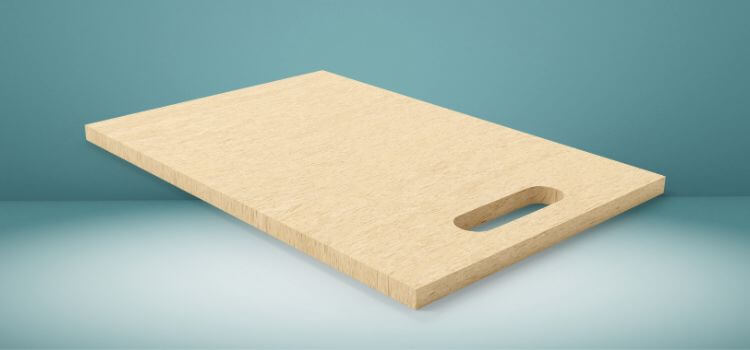As an Amazon Associate, I earn from qualifying purchases

To fix a warped cutting board, soak it in water and then use heavy objects to flatten it as it dries. This simple method can effectively reverse warping and restore its flat surface.
A warped cutting board can be a frustrating kitchen issue, disrupting your food preparation process. This common problem occurs when the wood absorbs moisture unevenly, causing it to bend or twist. Luckily, fixing a warped cutting board is not as daunting as it might seem.
With the right approach, you can quickly return your board to its original, flat condition. Ensuring your cutting board remains flat is not only crucial for safety but also helps in maintaining its longevity. Following a few straightforward steps can make your cutting board as good as new, ready to assist you in your culinary endeavors. Remember, taking proactive measures to prevent warping is just as important as knowing how to fix it.
Introduction
Discover the practical steps to salvage a warped cutting board and restore its flat surface. This guide offers effective techniques for straightening out your essential kitchen tool, ensuring a safe and stable chopping experience.
Discovering a warped cutting board in your kitchen can be a frustrating experience, especially when it disrupts your meal prep routine. But before you consider throwing it away, know that there are effective methods to restore your board to its original flatness.
With a bit of patience and the right technique, you can fix that warped cutting board and get back to slicing and dicing with ease.
Identifying The Type Of Warpage
Before attempting to fix your cutting board, it’s crucial to understand the nature of the warp. There are generally two types of warping: cupping and twisting. Cupping occurs when the board’s edges curl upwards or downwards, while twisting happens when the corners lift or dip, creating an uneven surface.
Recognizing which type of warp your board has will determine the corrective measures you need to take.
Materials Needed For The Fix
To tackle the warp in your cutting board, you’ll need a few household items:
- Heavy objects: To apply pressure on the board.
- Damp cloth: For adding moisture to the wood.
- Sandpaper: To smooth out any uneven areas post-treatment.
Gathering these materials beforehand will streamline the process and increase your chances of successfully flattening the board.
Step-by-step Repair Process
Correcting a warped cutting board involves a series of steps that, when followed carefully, can lead to satisfying results. Begin by laying the board on a flat surface and applying moisture if the warp is minor. For more severe cases, use a combination of heat and pressure over an extended period.
Ensure the board is completely dry before using it again, as moisture can lead to bacterial growth and further warping.
Preventing Future Warping
Maintaining your cutting board is just as important as fixing it. To prevent future warping:
- Store the board flat: This keeps it from bending under its own weight.
- Keep it dry: Wipe off excess water immediately after washing.
- Oil it regularly: Conditioning the wood helps maintain its integrity.
By following these simple care tips, you can extend the life of your cutting board and minimize the chances of warping.
Embracing these guidelines can not only save your cutting board but can also save you time and money. Roll up your sleeves, and let’s bring that cutting board back to its prime!
Understanding Warped Cutting Boards

Warped cutting boards can compromise your food preparation safety and efficiency. Learn the tricks to straighten your board and restore its flat surface with practical, step-by-step solutions.
Discovering your cutting board has warped can be a kitchen nightmare, especially when you’re all set to chop ingredients for your favorite dish. But don’t worry; understanding why this happens and how to fix it can bring your cutting board back to its best form.
Let’s dive into the basics of warped cutting boards and set the stage for a successful restoration.
Why Do Cutting Boards Warp?
Warped cutting boards are a common issue, stemming from a variety of reasons. It’s essential to pinpoint the cause to apply the correct fixing method. Here’s what you need to know:
- Uneven drying: When one side of the cutting board dries faster than the other, it causes the board to warp. This is often due to improper washing or drying methods.
- Excessive moisture: Boards exposed to too much moisture for prolonged periods can also warp. This usually happens when they are left soaking in water.
- Heat exposure: Placing a cutting board near a heat source, like an oven or a sunny window, can lead to warping due to the uneven expansion and contraction of the wood fibers.
Understanding these causes is the first step in preventing future warping and fixing the current issue.
How To Straighten A Warped Cutting Board
Straightening a warped cutting board requires patience and the right technique. Here’s a straightforward method to get you started:
Firstly, it’s vital to assess the degree of warping. Minor warps can often be fixed with simple methods, while severely warped boards may need more intensive care. Follow these steps for an effective fix:
- Moistening the board: Apply a light layer of moisture to the concave side of the board. This helps in expanding the wood fibers gently.
- Applying heat: After moistening, use a hairdryer on a low setting to evenly apply heat. This aids in the even expansion of the wood, helping it to flatten.
- Weight application: Place a heavy object or weights evenly across the board’s surface. Leave it undisturbed for at least 24 hours.
This method can significantly improve the flatness of your cutting board, making it ready for use once again.
Embracing these insights can not only save your favorite cutting board but also extend its life, ensuring it remains a reliable tool in your culinary adventures. Remember, taking proactive steps to care for your cutting board can prevent warping from happening in the first place, keeping your kitchen prep smooth and efficient.
Assessing The Damage
Discover the secrets to restoring a warped cutting board with precision. Begin by evaluating the extent of the warping before embarking on the repair process, ensuring your cutting board returns to top-notch condition.
A warped cutting board can be a real nuisance in the kitchen, but before you consider throwing it out, let’s evaluate the extent of the damage. With the right approach, you may be able to restore your cutting board to its former glory.
Before diving into repairs, it’s crucial to understand the severity of the warping. A visual inspection will often reveal whether the cutting board is salvageable.
- Degree of Warping: Check how much the board curves by placing it on a flat surface. If the warping is slight, the chances of successful repair are higher.
- Type of Material: Determine if your cutting board is made of wood, bamboo, or plastic. Wooden boards are typically more amenable to corrective measures.
- Cracks and Splits: Look for any cracks that may have developed. These can worsen with attempts to straighten the board and may require additional repairs.
- Moisture Content: Feel the board for dampness. Excessive moisture is often the culprit behind warping and will need addressing before any flattening efforts.
Analyzing Warping Patterns
Understanding the warping pattern is essential for choosing the right fixing method. Here’s what to look out for:
- Direction of the Warp: Notice if the board is cupped, twisted, or bowed. Each type of warp will require a different strategy to correct.
- Consistency of the Surface: Run your hand across the board. A consistent surface may indicate that the board has warped evenly, simplifying the repair process.
- Edges and Corners: Examine the edges and corners. If these areas are severely distorted, it may affect the board’s stability during use.
Once you’ve thoroughly assessed the damage and understood the nature of the warp, you can proceed with the most appropriate repair method for your cutting board. Remember, patience and careful observation are your best tools in bringing your cutting board back to a functional state.
Methods To Fix A Warped Cutting Board

Discover practical techniques to straighten a warped cutting board, ensuring a stable and flat surface for your food preparation tasks. Explore simple, effective strategies to restore your cutting board’s shape and enhance kitchen safety.
Understanding Wood Warping
Before diving into the solutions, it’s crucial to recognize that wood is a living material. It responds to changes in humidity and temperature by expanding or contracting. A cutting board can become warped if one side is exposed to more moisture than the other, causing an imbalance.
Fortunately, there are practical methods to correct this common kitchen mishap.
The Water And Heat Method
Applying water and heat can effectively reverse warping. Here’s how:
- Wet the concave side: Moisten the side of the cutting board that dips inward, using a sponge or cloth.
- Apply heat: Place the board with the wet side up in a sunny spot or use a hairdryer to gently warm the surface.
- Add weight: Once warm, flip the board and place a heavy object on top to help flatten it as it dries.
- Let it sit: Allow the cutting board to dry completely, which may take a day or two.
The Opposite Side Treatment
Sometimes, treating the opposite side of the warp can bring the board back to flatness. This involves:
- Identifying the warp: Determine which side of the cutting board is bulging outward.
- Moistening: Apply a damp cloth to the bulging side, ensuring it’s evenly wet.
- Pressing down: Place the board on a flat surface with the moistened side down.
- Applying weight: Stack heavy books or other weights on top of the cutting board.
- Waiting: Leave the weights on for at least 24 hours.
The Wood Conditioning Technique
Wood conditioning is another approach to address a warped cutting board. It not only helps fix warping but also prevents future occurrences.
- Clean the board: Start with a clean, dry cutting board.
- Apply conditioner: Use a food-safe wood conditioner or mineral oil to coat the entire board.
- Rub evenly: Spread the conditioner uniformly, covering all sides, edges, and surfaces.
- Leave to absorb: Allow the conditioner to penetrate the wood fibers overnight before wiping off any excess.
Balancing Humidity Exposure
To prevent warping, it’s important to balance the cutting board’s exposure to humidity:
- Store properly: Keep your cutting board in a dry area away from extreme temperatures.
- Avoid water pooling: Never submerge the board in water or leave it wet for prolonged periods.
- Regular maintenance: Periodically condition your board to maintain its moisture balance.
With these strategies, not only can you correct a warped cutting board, but you can also extend its life, ensuring it remains a flat, reliable surface for all your chopping needs. Remember, patience is key—some boards may take multiple treatments to fully flatten.
But with consistent care, your cutting board can continue to be a centerpiece of your culinary adventures.
Preventive Measures To Avoid Warping
Preventive measures are crucial to stop your cutting board from warping. Ensuring it never soaks in water and regularly oiling it can maintain its shape.
Store Your Cutting Board Properly
One of the key steps in preventing your cutting board from warping is to store it correctly. Keep it in a dry, stable environment where the temperature and humidity don’t fluctuate too much. If you lean it vertically against a wall or backsplash, ensure there’s enough air circulation to prevent moisture buildup, which could lead to warping.
Regular Maintenance Is Crucial
- Oil your board regularly: A well-moisturized cutting board is less likely to absorb water and warp. Using food-safe mineral oil, give your board a generous coating, let it soak in, and then wipe off the excess.
- Avoid prolonged exposure to water: Don’t let your board sit in water or stay wet for extended periods. After washing, dry it thoroughly with a towel and then allow it to air dry completely.
- Use both sides: Alternate which side of the cutting board you use. This helps in distributing the wear and minimizes the chances of warping from uneven usage.
Temperature And Humidity Control
Maintaining a consistent environment is paramount in preventing wood from warping. Extremes in temperature and humidity can cause the wood fibers to expand and contract unevenly, leading to a warped cutting board. Aim to keep your kitchen or storage area at a stable humidity level, and avoid placing your board near heat sources such as ovens or stovetops.
Invest In Quality
- Choose the right material: Opt for cutting boards made from hardwoods like maple, walnut, or cherry. These woods are more resistant to warping and last longer with proper care.
- Thickness matters: Thicker cutting boards are less likely to warp than thinner ones. They can withstand more moisture and wear, providing a stable cutting surface for a longer time.
- Consider the construction: Boards made with end grain or edge grain are less likely to warp compared to those made from a single flat piece of wood. The construction can help counteract the natural movement of the wood.
Clean Your Cutting Board Carefully
The way you clean your cutting board can influence its longevity and shape. Always clean it with mild soap and warm water, avoiding harsh chemicals that can strip the natural oils from the wood. Never leave it to soak in the sink, and don’t put it in the dishwasher, as the intense heat and prolonged exposure to water can cause warping.
By following these preventive measures, you can significantly reduce the risk of your cutting board warping over time. Regular maintenance, proper storage, and careful use are the cornerstones of keeping your cutting board flat and functional, ensuring it remains an indispensable tool in your culinary arsenal.
Maintenance Tips To Prevent Warping
Maintaining your cutting board is crucial to prevent future warping:
- Regular oiling: Keep the wood nourished to prevent drying out.
- Balanced use: Use both sides of the board evenly to avoid uneven stress.
- Proper storage: Store the board flat in a dry area away from extreme temperatures.
By following these guidelines, you’ll extend the life of your cutting board and keep it in top shape for all your slicing and dicing needs. Remember, a flat cutting board is not only more efficient but also safer to use.
So, take the time to care for it, and it will remain a steadfast companion in your culinary adventures.

Credit: rvacuttingboards.com
Frequently Asked Questions
Can A Cutting Board Be Unwarped?
Yes, a warped cutting board can often be unwarped by applying heat and moisture then weighting it down until flat.
How To Straighten A Warped Chopping Board?
To straighten a warped chopping board, lay it flat, apply moisture to the concave side, and leave it overnight with weight on top. Adjust moisture and weight as needed until the board flattens.
How To Flatten A Warped Board?
Lay the warped board flat, apply moisture to the concave side, and evenly distribute weight on top. Allow it to dry slowly. Use heat if necessary for more severe warping, but monitor closely to prevent damage.
How To Flatten An End Grain Cutting Board?
To flatten an end grain cutting board, start by sanding it with coarse sandpaper. Gradually move to finer grits for a smooth finish. Keep the surface even. Finally, apply a food-safe oil to protect and seal the wood. This process restores the board’s functionality and appearance.
Conclusion
Restoring a warped cutting board is simpler than it seems. With the right tools and patience, you can breathe new life into your kitchen staple. Remember, regular maintenance can prevent warping and extend your board’s longevity. Happy fixing, and here’s to many more years of seamless chopping!
As an Amazon Associate, I earn from qualifying purchases
Pingback: Walnut vs Maple Cutting Board